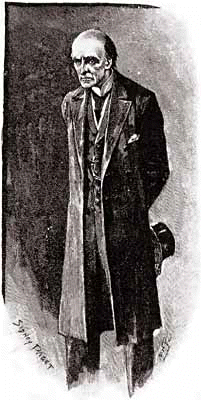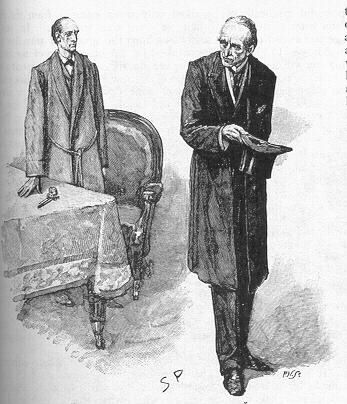 Real
Name: Professor James Moriarty
Real
Name: Professor James Moriarty
Identity/Class: Normal human
Occupation: Maths Professor, crimelord
Group Membership: Leader of his own criminal gang, and through that most of London's underworld
Affiliations: Sebastian Moran
Enemies: Sherlock Holmes, Dr.John Watson
Known Relatives: Colonel James Moriarty (brother)
Aliases: The Napoleon of Crime
Base of Operations: London
First Appearance: The Final Problem (1893)
Powers/Abilities: Moriarty was a criminal genius, very nearly as smart as his nemesis, Sherlock Holmes. While an older man and given to dealing with problems using his brains rather than brawn, he was clearly a good hand-to-hand fighter when pushed, as he was able to give the extremely strong, martial arts knowledgeable Holmes a run for his money when they fought atop the Reichenbach Falls.
History: He is the Napoleon of crime, Watson. He is the organizer of half that is evil and of nearly all that is undetected in this great city. He is a genius, a philosopher, an abstract thinker. He has a brain of the first order. He sits motionless, like a spider in the centre of its web, but that web has a thousand radiations, and he knows well every quiver of each of them. - 'The Final Problem' (1893), Sir Arthur Conan Doyle
The arch-nemesis of Sherlock Holmes, who ruled the London underworld in the late 19th century, before (apparently) meeting his death at the Reichenbach Falls at the hands of the great detective. An extremely intelligent man of good birth, Moriarty was a Professor of Mathematics, writing a treatise on the binomial theorem (The Final Problem), lecturing about eclipses, and becoming the celebrated author of "The Dynamics of An Asteroid", a book so advanced that "no man in the scientific press is able to criticize it". He left his University Chair to become an army coach, and then went to London. At first, in a manner similar to Holmes being a consulting detective, Moriarty was a consulting criminal, in one instance aiding a crime syndicate from America to track down "Birdy Edwards" (The Valley of Fear). Later he set up his own criminal syndicate, with Colonel Sebastian Moran as his right hand. In 1891, when Holmes disrupted his criminal activities, he pursued the detective across Europe to the aforementioned Falls in Switzerland, where the two fought and Moriarty fell to his death (perhaps).
 Comments:
Created by Sir Arthur Conan Doyle.
Comments:
Created by Sir Arthur Conan Doyle.
As the secret head of the criminal underground and with his incredible intellect, Moriarty could be argued to be one of the first supervillains. He and Moran are featured in The Final Problem, The Empty House and The Valley of Fear.
Moriarty had at least one brother, a station master in the West of England. In the Final Problem (as Traven reminds me) his brother Colonel James Moriarty writes letters defending the memory of his dead brother, which forces Watson to tell the true story. However, while this suggests that the Professor had two brothers, it is conceivably possible that Colonel Moriarty had retired to become the station master. Not likely though. So, definitely one brother, probably two. Traven points out that "station master" might mean "master of a military station", not a train station as many would assume.
Further observations from Traven: Moriarty was described as swinging his head from side to side like a snake about to strike, and this serpentine analogy is continued when he attacks Holmes, as he wraps his arms around him like a snake around it's prey.
Traven also noted the following details about the Napoleon of Crime: he mentioned Moriarty's mathematical publications, the time he spent as an army coach, that he paid his henchman Moran six thousand pounds a year (a huge amount in those days). He won over Inspector MacDonald of Scotland Yard, who stated that having visited the Professor, when he left "he (Moriarty) put his hand on my shoulder as we were parting, it was like a father's blessing before you go out into the cold cruel world". Moriarty had in his study a painting by a famous artist, which Holmes pointed out to MacDonald he could only have obtained through theft. Traven finishes by saying "I think the best thing about Moriarty is that he is not seen. He is behind the curtains working his evil. As PG Wodehouse put it "We don't need to have a villain who we know his thoughts. A villain should be like a force, a power (like a force of nature) and we are supposed to wonder 'my God, who can stand up to this person?'" Moriarty is like that. He is crime itself."
Others agree. In spite of seemingly dying at the Reichenbach Falls, many subsequent writers have used the Napoleon of Crime, both with and without the presence of his arch nemesis. As with Holmes after his apparent demise, the public refuse to allow Moriarty to rest in peace.
Thanks to "Traven" and Jim Herbert for corrections and additions.
CLARIFICATIONS: Professor Moriarty inspired both
-
Professor Moriarty, League of Extraordinary Gentlemen version
-
Professor Moriarty, the Fantom of the LXG movie
Any Additions/Corrections? Please let me know.
All images and characters depicted on this site are copyright their respective holders, and are used for informational purposes only. No infringement is intended and copyrights remain at source.